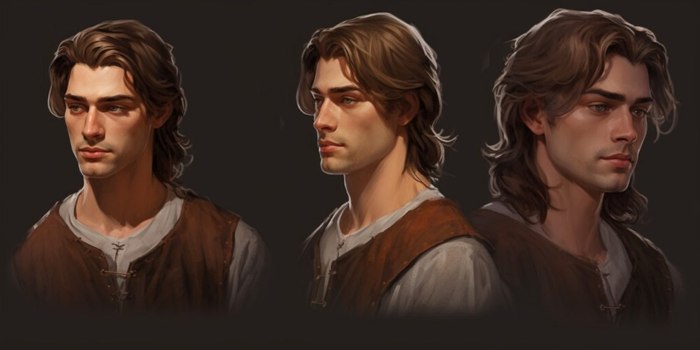From the clean-shaven heads of ancient civilizations to the elaborate hairstyles of the Renaissance and the sleek, modern looks of today, men’s hairstyles have undergone a fascinating evolution throughout history.

The way men have styled their hair is not merely a reflection of fashion trends but also a testament to cultural, social, and historical influences. Join us on a journey through time as we explore the rich and diverse history of men’s hair.
Ancient Civilizations: Shaving and Symbolism
In ancient civilizations, men’s hairstyles were often influenced by practical considerations and cultural beliefs. In ancient Egypt, for example, men were known for their clean-shaven heads, a style associated with hygiene and the hot climate. The Egyptian elite also used wigs and elaborate headdresses to denote social status and importance.
In ancient Greece, the beard held significant cultural and symbolic value. Beards were seen as a sign of masculinity, wisdom, and maturity. Philosophers like Socrates and Plato were often depicted with long, flowing beards, emphasizing the connection between facial hair and intellectual prowess.
The Roman Empire, however, took a different approach. The military culture of ancient Rome favored a clean-shaven look, as it was believed to prevent enemies from grabbing onto facial hair during battle. Roman emperors, such as Julius Caesar, set trends by adopting a clean-shaven appearance, influencing the masses to follow suit.
Medieval Times: The Rise of Elaborate Hairstyles
As we move into the medieval era, men’s hairstyles became more varied and expressive. In the early Middle Ages, long hair and beards were popular among the Germanic tribes. The Viking warriors, for example, were known for their long, braided hair and intricate beard styles.
During the Renaissance, men’s hairstyles became increasingly elaborate and symbolic of social status. The court of King Louis XIV of France set the stage for the extravagant wigs and hairpieces that would become iconic of this era. Powdered wigs, adorned with ribbons and jewels, were donned by aristocrats and nobles as a symbol of wealth and refinement.
18th and 19th Centuries: Wigs, Pomade, and Mustaches
The 18th century witnessed the continuation of wig-wearing among European nobility, but it gradually declined as the century progressed. The rise of the natural look came about with the advent of pomade, a hair styling product that gained popularity in the 19th century. Pomade allowed men to slick back their hair, creating a more polished appearance.
Mustaches also became a prominent feature during the 19th century. The Victorian era saw a variety of mustache styles, from the dapper handlebar mustache to the simple yet refined English mustache. Facial hair became a symbol of masculinity, and men’s grooming rituals expanded to include a range of products and tools.
20th Century: The Roaring Twenties to the Rebel Fifties
The 20th century brought about significant changes in men’s hairstyles, reflecting shifts in societal norms and cultural movements. The 1920s marked the emergence of the «flapper» style, with slicked-back hair and short, cropped cuts for men. The Jazz Age celebrated individualism and rebellion, setting the stage for more diverse hairstyles.
The 1950s witnessed a return to conservative grooming, with clean-cut looks inspired by Hollywood icons like James Dean and Elvis Presley. Pompadours and crew cuts became popular, reflecting a desire for a more polished appearance. The rebellious spirit of the Beat Generation and the emergence of rock ‘n’ roll challenged traditional grooming standards, leading to longer hair and a more casual aesthetic.
The Counterculture Revolution: 1960s and 1970s
The 1960s and 1970s marked a revolution in men’s hairstyles as counterculture movements rejected the conformity of the previous decades. The «hippie» movement embraced long hair, flowing locks, and natural styles as a rejection of mainstream ideals. The Beatles’ mop-top hairstyles became iconic symbols of this era, influencing a generation to embrace a more carefree and non-conformist approach to grooming.
The Punk and New Wave movements of the late 1970s and early 1980s brought about bold and unconventional hairstyles. Shaved heads, brightly colored hair, and spikes became synonymous with rebellion and anti-establishment sentiments. The punk aesthetic challenged traditional beauty standards, encouraging self-expression and individuality.
Contemporary Trends: Diversity and Individual Expression
As we move into the 21st century, men’s hairstyles have become more diverse than ever, reflecting the acceptance of individual expression and breaking down traditional gender norms. The «lumbersexual» trend of the 2010s embraced a rugged aesthetic with full beards and unkempt hairstyles, challenging the clean-shaven looks of the past.
Today, men’s grooming is characterized by a wide range of styles, from the classic fade and undercut to the bold and unconventional. The popularity of facial hair has made a resurgence, with beards and mustaches taking on various shapes and sizes. The influence of social media and popular culture has created a landscape where trends evolve rapidly, and men feel empowered to experiment with their looks.
Conclusion
The history of men’s hairstyles is a captivating journey through the ages, reflecting cultural, social, and historical shifts. From the practicality of ancient civilizations to the symbolism of medieval times, the extravagance of the Renaissance, and the rebellious spirit of the 20th century, men’s grooming has always been a dynamic and ever-changing expression of identity.
As we navigate the diverse landscape of contemporary grooming trends, it’s clear that men’s hairstyles continue to evolve, embracing individuality and self-expression. Whether inspired by the past or paving the way for the future, men’s hair will undoubtedly remain a powerful form of personal expression, telling stories of cultural movements, societal norms, and the ever-changing face of fashion.